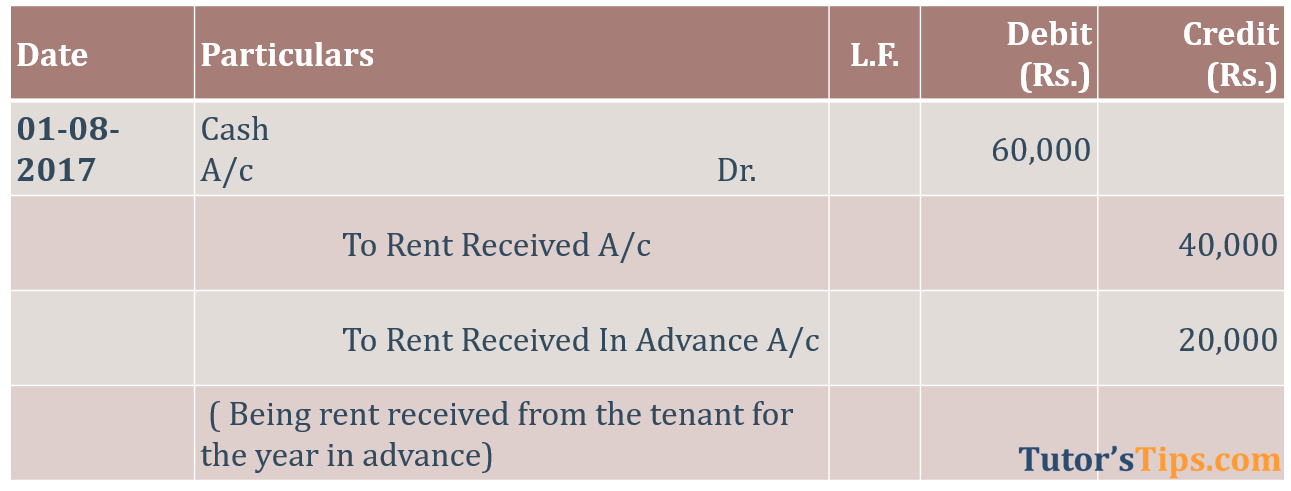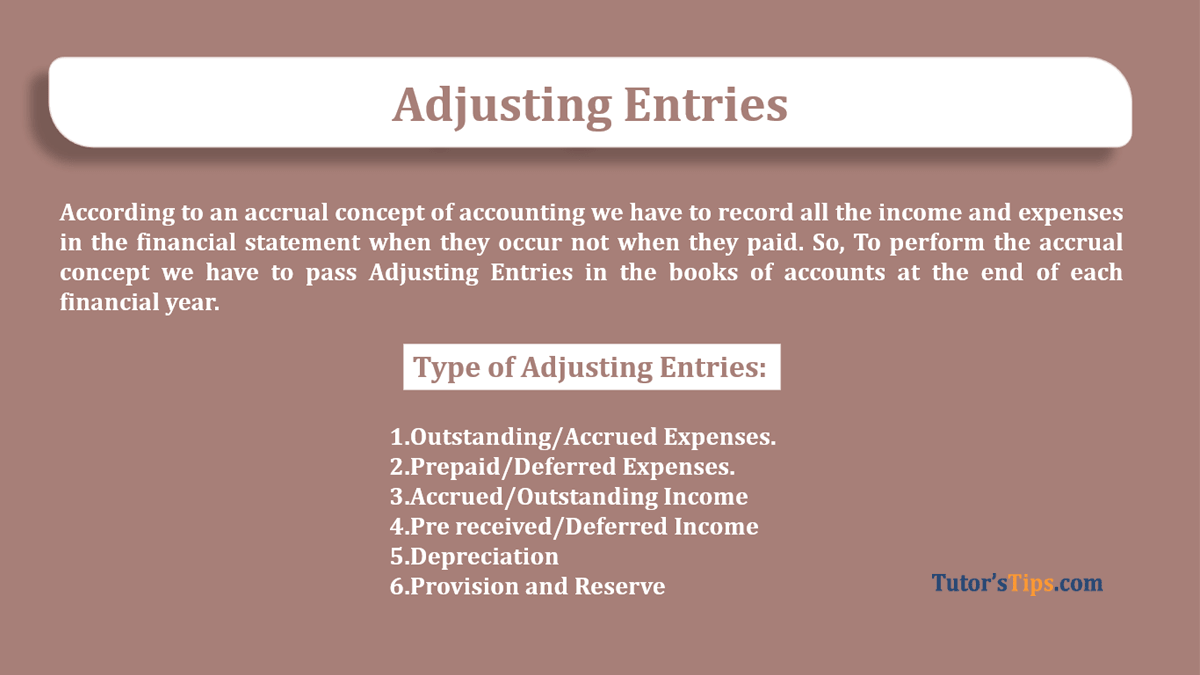The Content covered in this article:
समायोजन प्रविष्टियों (Adjusting Entries) का परिचय
लेखांकन की एक आकस्मिक अवधारणा (accrual concept) के अनुसार हमें वित्तीय आय में सभी आय और खर्चों को रिकॉर्ड करना होगा जब वे भुगतान नहीं करते हैं। अतः, हमें इस अवधारणा को पूरा करने के लिए प्रत्येक वित्तीय वर्ष के अंत में खातों की पुस्तकों में समायोजन प्रविष्टियाँ (Adjusting Entries) पास करनी होंगी।
तो समायोजन प्रविष्टियों (Adjusting Entries) की सहायता से, हम कंपनी / फर्म / संगठन की वास्तविक वित्तीय स्थिति प्राप्त कर सकते हैं। यह उदाहरण के लिए सभी खातों के वास्तविक संतुलन की पुष्टि करता है। व्यय, आय, संपत्ति और देयताएं।
समायोजन प्रविष्टियों (Adjusting Entries) का प्रकार:
निम्नलिखित समायोजन प्रविष्टियों (Adjusting Entries) के प्रकार हैं: –
- बकाया / जमा खर्च (Outstanding/Accrued Expenses)
- प्रीपेड / आस्थगित व्यय (Prepaid/Deferred Expenses)
- जमा / बकाया आय (Accrued/Outstanding Income)
- पूर्व में प्राप्त / आस्थगित आय (Pre received/Deferred Income)
- मूल्यह्रास (Depreciation)
- प्रावधान और रिजर्व (Provision and Reserve)
1. बकाया / जमा खर्च (Outstanding/Accrued Expenses): –
इसका मतलब है कि उन खर्चों को जो अभी तक भुगतान नहीं किया गया था।
उदाहरण के लिए (For Example):
The salary Rs 50,000/- for the month of March-18 paid in April-18. Pass the journal entry for the year ended 31st March 2018.
उपाय (Solution):
Advertisement
We have to pass journal entry at the end of the financial year means 31st March 2018 to record the correct amount of expenses.
नोट: यदि आपको नहीं पता है कि लेखांकन के इस नियम को कैसे लागू किया जाए तो कृपया इस लिंक को देखें
https://tutorstips.in/golden-rules-of-accounting
लेन-देन में, दो खाते वेतन और बकाया वेतन शामिल हैं।
Salary -> Expense a/c -> Nominal rule ->Expense met by Business -> Debit
Outstanding Salary -> Representative person -> Personal rule -> giver – > Credit
Advertisement

2. प्रीपेड / आस्थगित व्यय (Prepaid/Deferred Expenses).
इसका मतलब है कि उन खर्चों का भुगतान किया गया था जो अभी तक नहीं किए गए थे।
उदाहरण के लिए (For Example):
Paid 15,000/-for the insurance of inventories taken up June-18. Pass the journal entry for the year ended 31st March 2018.
उपाय (Solution):
So in this transaction, we have paid 3 months extra premium for insurance which is actually related to next year that why cannot claim this expense in this financial year. So, the treatment of this transaction are as following:
लेन-देन में, दो खाते बीमा और प्रीपेड बीमा शामिल हैं।
Insurance -> Expense a/c -> we had given extra Debit to this account so, now -> Credit it.
Prepaid Insurance -> Representative person -> Personal rule -> Receiver – > Debit
अब प्रीपेड बीमा की राशि की गणना करें
15000* 3/12 = 3,750/-

3. जमा / बकाया आय (Accrued/Outstanding Income):
इसका मतलब है कि वे आयें जो अभी तक प्राप्त नहीं हुई थीं, लेकिन बढ़ी हुई थीं।
उदाहरण के लिए (For Example):
The rent for the month of March-18 due but not received yet from the tenant for Rs 20,000/-.Pass the journal entry for the year ended 31st March 2018.
इसलिए इस लेनदेन में, हम निम्नलिखित के रूप में दिखाए गए लेखांकन के सुनहरे नियमों के साथ दो खातों का इलाज करेंगे।
Accrued Rent A/c -> Representative personal A/c -> Personal Rule -> Tenant using our cash for other propose. So, he is the receiver -> Debit
Rent received A/c -> Income A/c -> Nominal Rule -> Rent Earned -> Credit

4. पूर्व में प्राप्त / आस्थगित आय (Pre received/Deferred Income):
इसका मतलब है कि आय प्राप्त हुई है लेकिन अभी तक अर्जित नहीं की गई है।
उदाहरण (Example):
On 01/08/2017, rent received for the let-out building for the period of one year in advance. Pass the journal entry for the year ended 31st March 2018.
तो इस लेनदेन में, हम निम्नलिखित के रूप में दिखाए गए लेखांकन के सुनहरे नियमों के साथ तीन खातों का इलाज करेंगे।
Cash a/c -> Asset A/c -> Real Rule -> Cash Comes in -> Debit
Rent received A/c -> Income A/c -> Nominal Rule -> Rent Earned -> Credit
Advance Rent received A/c -> Representative personal A/c -> Personal Rule -> Tenant paying cash, giver -> Credit

5. मूल्यह्रास (Depreciation):
यह समय गुजरने से निश्चित परिसंपत्तियों के मूल्य में कमी का मतलब है। यह केवल अचल संपत्तियों (fixed assets) (भूमि को छोड़कर) पर लगाया जाता है क्योंकि प्रत्येक अचल संपत्ति में एक वर्ष से अधिक का जीवन होता है, लेकिन अनिश्चित काल तक नहीं चलेगा और भूमि का अनिश्चित काल तक जीवन रहेगा इसलिए इसे सराहना मिलेगी।
उदाहरण (Example):
Depreciation charged on building @ 10% on Rs 10,00,000/-. Pass the journal entry for the year ended 31st March 2018.
हम दो खाते का इलाज करेंगे
Depreciation Account -> is Expenses -> Nominal Rule -> All Expenses -> Debited
Building Account -> is an Assets ->Real Rule -> Goes out -> Credited

6. प्रावधान और रिजर्व (Provision and Reserve)
प्रावधान और रिजर्व का मतलब भविष्य में देनदारियों को पूरा करने के लिए वित्तीय वर्ष के लाभ का एक हिस्सा बनाए रखना है। वित्तीय विवरण को अंतिम रूप देते समय, जिसकी राशि को अंतिम रूप नहीं दिया गया है।
उदाहरण (Example):
Provision made for the Doubtful debt 5% on total debtors of 100,000/-. Pass the journal entry for the year ended 31st March 2018.
उपाय (Solution):
Amount of Provision is 100,000 * 5% = 5,000/-
प्रावधान खाते के दो उपचार निम्नानुसार हैं: –
- हम बैलेंस शीट के देयता पक्ष में प्रावधान / सी दिखा सकते हैं।
- उस परिसंपत्ति की राशि से प्रावधान की राशि घटाएं जिसके लिए इसे बनाया गया था।
1.हम बैलेंस शीट के देयता पक्ष में प्रावधान को दिखा सकते हैं:
इस उपचार में, हमें केवल एकल जर्नल प्रविष्टि को निम्नानुसार पास करना होगा: –
1. Provision for doubtful debt Account -> this account is representing the group of defaulter -> So it will be treated as Representative Person -> So Personal Rule applied -> we assume that we can not recover the due amount from them -> so now they giving us loss -> it means they are giver -> Credit
2. Profit/loss Account ->is Income & expenses a/c -> Provision is made for future loss/expenses-> so Nominal Rule applied -> all losses and Expenses are debit -> Debit

2. प्रावधान की राशि घटाएँ: –
एक परिसंपत्ति की राशि से प्रावधान की राशि घटाएं जिसके लिए इसे बनाया गया था, हमें दो जर्नल प्रविष्टियाँ दर्ज करनी होंगी जैसे कि: –
उपरोक्त उपचार में पहले जर्नल की प्रविष्टि समान है।
दूसरे जर्नल प्रविष्टि में, हम उस परिसंपत्ति खाते के लिए प्रावधान की राशि स्थानांतरित करेंगे जिसके लिए यह बनाया गया था: –
1. Provision for doubtful debt Account -> Closing the account of the provision by Debiting it -> Debit
2. Sundry Debtors Account -> Asset -> Real Rule -> Goes out -> Credit

समायोजन प्रविष्टियों के विषय को पढ़ने के लिए धन्यवाद,
कृपया अपनी प्रतिक्रिया पर टिप्पणी करें जो आप चाहते हैं।
या
अगर आपका कोई सवाल है तो हमें कमेंट करके पूछें

